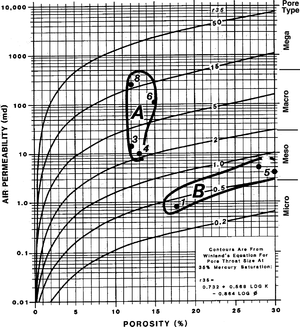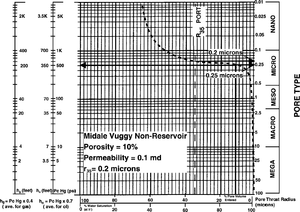Midale porosity, pore geometries, and petrophysics
| Exploring for Oil and Gas Traps | |

| |
| Series | Treatise in Petroleum Geology |
|---|---|
| Part | Predicting the occurrence of oil and gas traps |
| Chapter | Predicting reservoir system quality and performance |
| Author | Dan J. Hartmann, Edward A. Beaumont |
| Link | Web page |
| Store | AAPG Store |
Reservoir pore geometry and pore type
Most of the porosity in the vuggy packstone facies is molds and vugs developed by solution of micrite, algal clasts, and skeletal fragments. There is a range in sizes of the vugs. Most of the larger vugs are connected and effective. Smaller pinpoint vugs and molds lack interconnection and are ineffective. The vuggy packstone facies also contains intergranular (partly modified to intercrystalline) meso- to macroporosity. On the basis of scanning electron microscope (SEM) analyses, the particles are larger than 50μ (equivalent to very fine-grained sand). Capillary pressure data and petrographic analyses indicate the vugs and intergranular pore throats are large, 4-10μ, and well sorted. The r35 analyses (port size) puts the reservoir facies in the macropore type.
Reservoir character

Good reservoir properties are seen in the vuggy packstone facies, congruent with the observed pore geometries. Permeabilities in rock with only 10% porosity are as high as 10 md.
Figure 1 is a crossplot of routine core porosity and permeability from the Midale in an example well at Weyburn field. The diagonal lines are contours of equal r35 values. On the plot, vuggy packstone facies (group A; data points 3, 4, 6, and 8) are characterized by lower porosity but higher permeability.
Nonreservoir pore geometry and pore type
In contrast to the vuggy packstone facies, the porous mudstone facies displays poor permeability (5 md or less), even though porosity can be as high as 30% (points 1 and 5, group B in Figure 1). This is because the porosity is pinpoint vugs isolated within fine intercrystalline meso- to microporosity formed by silt-sized (10μ or less) dolomite rhombs. Capillary pressure and SEM data indicate the pore throats are less than 1μ in radius, with an abundance of pore throats about 0.5μ in radius or smaller (see Figure 2). Port size puts much of this rock in micropore type. While localized lenses of porous mudstone have as much as 30% porosity and 20 md permeability, these probably are laterally isolated from each other.
See also
- Evaluation of trap type
- Weyburn field location and trap problem
- Midale lithofacies and distribution
- Effect of pore geometry on Sw in Midale rocks
- Weyburn seal capacity
- Midale seal capacity and trap type
References
- ↑ Coalson, E. B., S. M. Goolsby, and M. H. Franklin, 1994, Subtle seals and fluid-flow barriers in carbonate rocks, in J. C. Dolson, M. L. Hendricks, and W. A. Wescott, eds., Unconformity Related Hydrocarbons in Sedimentary Sequences: RMAG Guidebook for Petroleum Exploration and Exploitation in Clastic and Carbonate Sediments, p. 45–58.
